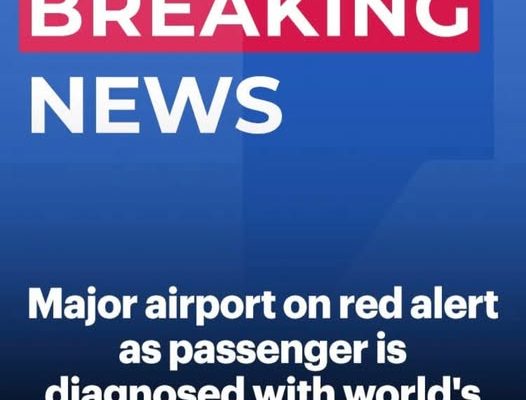Chicago O’Hare International Airport has been placed on alert after health officials confirmed that a traveler carrying measles spent two full days inside one of its busiest terminals. Authorities are urging passengers to stay informed, monitor for symptoms, and check their vaccination records as a precautionary step against the spread of infectious diseases.
Timeline of Events in Terminal 1
The incident took place on April 22 and April 23, when an adult passenger—later diagnosed with measles—spent long hours in Terminal 1, including at security checkpoints, lounges, and crowded waiting areas.
Although this individual had previously received one dose of the MMR (measles, mumps, rubella) vaccine, they were still contagious during their time at the airport. Since measles can remain airborne for several hours, travelers who were in the same spaces may have been at risk, even without direct contact.
Symptoms began showing a few days later, with the classic measles rash appearing on April 25. After diagnosis, the passenger followed public health guidance and began self-isolating at home to avoid further exposure to the community.
Additional Cases Under Review
Soon after, a second adult case was reported in the same Illinois county. Investigators are still working to determine whether this case is directly linked to the airport exposure or if it represents a separate infection. The patient’s vaccination status has not yet been confirmed.
Local hospitals quickly isolated the second patient when they sought care on April 28, emphasizing the importance of swift containment, particularly for populations most vulnerable to complications, such as infants, the elderly, and those with weakened immune systems.
Understanding Measles and Its Risks
Measles is a highly contagious viral illness spread through respiratory droplets. What makes it particularly concerning is that the virus can stay suspended in the air for hours after an infected person leaves a room or space.
Typical symptoms appear 1–2 weeks after exposure and may include:
-
High fever
-
Cough
-
Runny nose
-
Red, watery eyes
-
A distinctive rash that spreads across the body
In some cases, serious complications such as pneumonia or brain inflammation can occur, especially among unvaccinated individuals.
Public Health Response
The Illinois Department of Public Health (IDPH), in partnership with the Centers for Disease Control and Prevention (CDC), launched a thorough contact-tracing effort. Travelers who passed through O’Hare’s Terminal 1 during the exposure window are being asked to:
-
Monitor themselves for symptoms, especially fever or rash
-
Review their vaccination history
-
Seek prompt medical care if symptoms develop
Officials stress that vaccination status is a key protective factor.
Importance of Vaccination
The MMR vaccine remains the strongest safeguard against measles. Two doses are recommended for full protection, which is effective in about 97% of people. A single dose provides partial coverage but may not always prevent infection, as seen in this case.
Health experts highlight that community protection—or “herd immunity”—relies on high vaccination rates. This is particularly important in crowded travel hubs such as airports.
Challenges in Airport Settings
Airports are uniquely challenging when it comes to controlling disease spread. With thousands of people moving through enclosed spaces daily, even a short exposure period can be enough for transmission.
Following the O’Hare incident, airport officials increased sanitation in Terminal 1, improved ventilation, and shared health guidance with passengers. Announcements and signs were used to inform travelers about potential risks and next steps.
Passenger Reactions
Travelers present during the exposure shared mixed emotions.
One passenger commented:
“I was there on April 22 for a connecting flight. When I heard about the exposure, I immediately checked my vaccination history. It’s a reminder that being prepared is important, even during routine travel.”
Another traveler added:
“Airports bring people together from all over the world. Staying vaccinated and being mindful of hygiene are the best protections we have.”
Expert Recommendations
Health professionals are encouraging people to remain calm but attentive. Dr. Angela Whitman, an infectious disease specialist, explained:
“While measles is extremely contagious, vaccination and early recognition of symptoms significantly reduce risks. Anyone concerned about exposure should consult their healthcare provider.”
The CDC also advises travelers to confirm their vaccination status before international trips or visits to major airports.
Broader Public Health Perspective
This incident serves as a reminder that even in regions with generally high vaccination coverage, outbreaks remain possible when immunity gaps exist.
Public cooperation—such as reporting illnesses promptly, following isolation guidelines, and staying current on vaccines—is essential to preventing larger outbreaks.
Moving Forward and Preventing Future Risks
Airports, airlines, and travelers all share responsibility for reducing health risks. Effective measures include:
-
Improved air circulation systems
-
Frequent cleaning of common areas
-
Clear health communication for passengers
On an individual level, travelers can help by:
-
Practicing good hand hygiene
-
Avoiding close contact with visibly ill individuals
-
Staying updated on vaccinations
Current Outlook
So far, no large outbreak has been linked to the O’Hare exposure, but health officials continue to monitor the situation closely. Contact tracing, follow-up testing, and community notifications remain ongoing.
Clear and accurate communication from health departments, airports, and the media is playing a key role in maintaining public trust and ensuring that travelers take the necessary precautions.
Conclusion
The measles exposure at Chicago O’Hare International Airport highlights the importance of vigilance in high-traffic environments. While concerning, the quick response by health officials, combined with effective communication and vaccination awareness, has helped reduce the risk of widespread transmission.
For travelers, the lesson is clear: keeping vaccinations up to date and being alert to potential symptoms remain vital steps in protecting both personal and public health. For public health leaders, the incident underscores the need for ongoing preparedness and cooperation across agencies.



